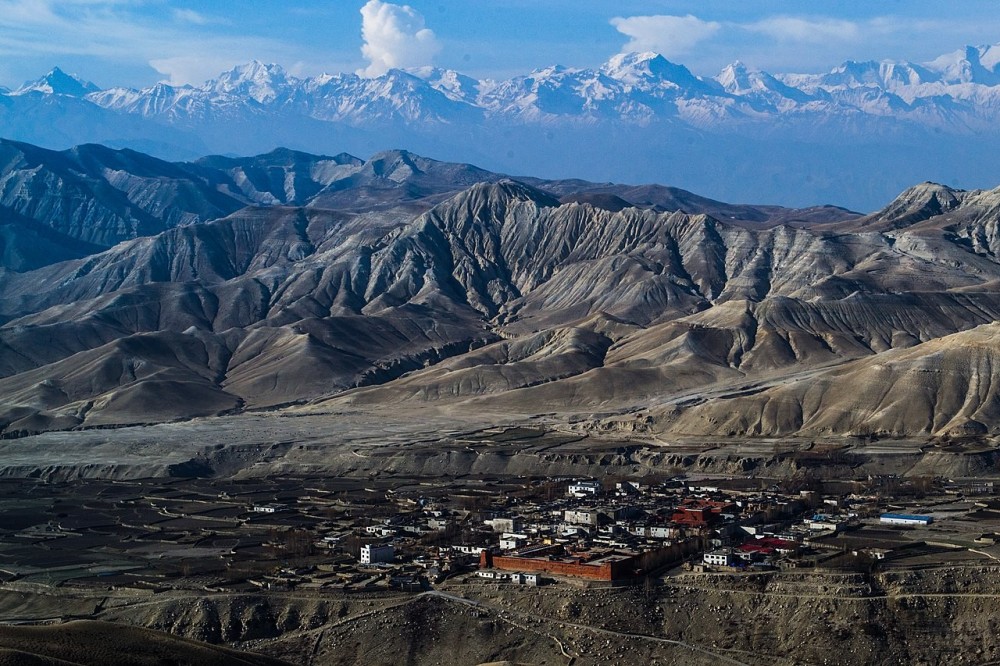Mustang, often referred to as "The Last Forbidden Kingdom," is a remote and culturally rich region in northern Nepal. Nestled between the Dhaulagiri and Annapurna mountain ranges, Mustang is renowned for its stark, high-altitude desert landscape, characterized by deep gorges, arid plateaus, and dramatic rock formations. This region, divided into Lower and Upper Mustang, features some of the most breathtaking and rugged terrain in Nepal. Its unique geography is complemented by a vibrant Tibetan-influenced culture, with ancient monasteries, traditional villages, and a way of life that closely resembles that of Tibet.
The capital of Upper Mustang, Lo Manthang, is a historic walled city that offers a glimpse into the region's royal past and its deep-rooted Buddhist heritage. Trekkers and visitors to Mustang are treated to stunning views, ancient caves, and spiritual sites like Muktinath, a sacred pilgrimage destination for both Hindus and Buddhists. Access to Mustang requires special permits due to its restricted status, but the effort is rewarded with an unparalleled experience of Nepal's high-altitude beauty and the preservation of its traditional Tibetan culture.
Geographical and Cultural Overview:
1.Geography:
- Location: Mustang is situated in the Himalayas, north of the Annapurna region, and is part of the Dhaulagiri Zone.
- Terrain: The region features a dramatic high-altitude desert landscape, characterized by arid, barren land, deep gorges, and rock formations. It is divided into two parts: Lower Mustang and Upper Mustang.
- Altitude: The elevation ranges from around 2,500 meters (8,200 feet) in the lower parts to over 4,000 meters (13,000 feet) in the upper regions.
2.Culture:
- Ethnic Groups: The inhabitants of Mustang are primarily ethnic Tibetans and their culture closely resembles that of Tibet. The local people, known as Loba, practice Tibetan Buddhism and speak the Loba language.
- Religion: Tibetan Buddhism is the predominant religion in Mustang, with numerous monasteries and prayer flags dotting the landscape. The region has a deep spiritual heritage and many traditional festivals are celebrated.
- Traditions: Mustang is known for its preserved ancient Tibetan customs and practices. Traditional dress, festivals, and rituals remain an integral part of life in this region.
Tourism and Attractions:
1.Lo Manthang:
- Historical Capital: Lo Manthang, the capital of Upper Mustang, is a historic walled city with ancient monasteries, palaces, and traditional Tibetan architecture. It was once a kingdom and remains a significant cultural and historical site.
- Must-See Sites: Key sites include the Royal Palace, Thubchen Monastery, and the numerous ancient caves and temples surrounding the city.
2.Muktinath:
- Sacred Site: Muktinath is a significant pilgrimage site for both Hindus and Buddhists. It is located near the Thorong La Pass and is famous for its sacred temples and natural springs.
3.Kagbeni:
- Gateway to Upper Mustang: Kagbeni is a picturesque village that serves as the gateway to Upper Mustang. It is known for its traditional architecture and stunning views of the Kali Gandaki River.
4.Ancient Caves and Monasteries:
- Cave Systems: Mustang has numerous ancient caves that were used by early inhabitants for meditation and residence. Some of these caves are located in dramatic cliff faces.
- Monasteries: Several ancient monasteries and gompas (Buddhist monasteries) can be explored throughout the region, offering insights into the spiritual and cultural life of the locals.
Trekking and Travel:
1.Trekking:
- Trekking Routes: Popular treks in Mustang include the Upper Mustang Trek and the Lo Manthang Trek. These treks offer a chance to explore the region’s remote landscapes, ancient cultural sites, and traditional villages.
- Permits: Special permits are required to enter Upper Mustang, as it is a restricted area. Trekking permits are issued by the Nepalese government and must be arranged in advance through a trekking agency.
2.Access:
- Transportation: Access to Mustang typically involves flying from Pokhara to Jomsom, followed by a trek or jeep ride to Upper Mustang. The region is also accessible via overland travel, but road conditions can be challenging.
3.Best Time to Visit:
- Seasons: The best time to visit Mustang is during the spring (March to May) and autumn (September to November) when the weather is more stable and conducive for trekking.


Comments (0)